Los Angeles County has thousands of ‘unclaimed dead.’ These investigators retrace their lives
LOS ANGELES (AP) — Arusyak Martirosyan struggles to open the door of a stranger’s one-bedroom apartment overflowing with the belongings from a life lived but not claimed in death.
Wedged against the door is a giant box of Gain laundry detergent and plastic tubs piled high. Blouses and T-shirts, suspended by hangers over a living room curtain rod, block out almost all sunlight. Bins and boxes, brimming with more clothes, hide the carpet. Empty takeout containers and Tupperware, with bugs trapped inside, cover the stove.
The 74-year-old woman died in October in the hospital, and weeks later no one had come forward for her remains. Wearing a Tyvek protective suit and trailed by the building’s property manager, Martirosyan hunts for a greeting card or letter sent to her that could have a family member’s address on the return label — anything that would lead to a relative who could give this woman a proper burial.
Martirosyan acts as a living representative of those Los Angeles County calls “the unclaimed dead.” She is one of more than a dozen investigators who work for the Public Administrator, an understaffed and little-known branch of the county’s Department of the Treasurer and Tax Collector.
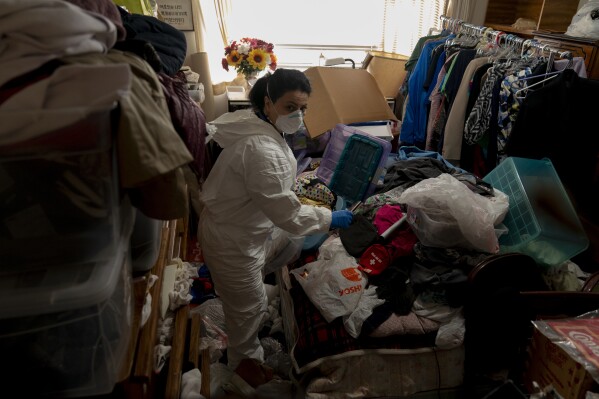
Arusyak Martirosyan, an investigator with the Los Angeles County Public Administrator’s office, searches through a cluttered one-bedroom apartment in Los Angeles, Thursday, Nov. 16, 2023, for clues that might lead to finding family members or relatives of a tenant who died in the hospital with no apparent next of kin. (AP Photo/Jae C. Hong)
Her job is to unearth who the woman was beneath all her belongings and find out who she loved, who loved her and what she wanted after her death.
Martirosyan and her colleagues spend three years investigating a case before relinquishing the deceased to a communal gravesite, a last resort in the county cemetery. Similar work is done in cities across the U.S. but in Los Angeles, with one of the nation’s largest homeless populations, the efforts are particularly difficult.
It is a painstaking process to retrace a life. Investigators, who handle about 200 cases yearly, are given a manila file folder containing a name, birthdate and little else for each death.
“I go through their lives in so many ways,” Martirosyan said. “They do become mine.”
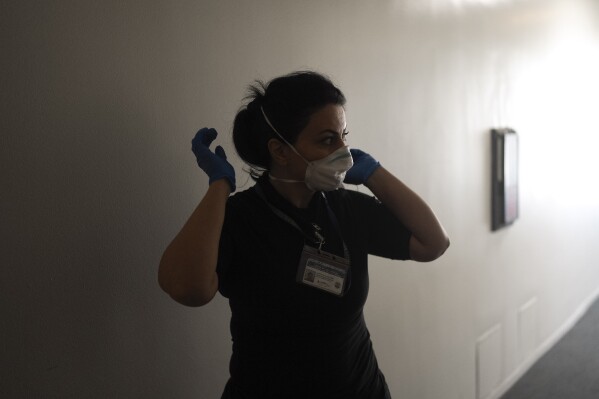
Arusyak Martirosyan, an investigator with the Los Angeles County Public Administrator’s office, puts on a protective mask before entering a one-bedroom apartment in Los Angeles, Thursday, Nov. 16, 2023. (AP Photo/Jae C. Hong)
In the beginning, it’s a race against time. The person’s body lays frozen in the county morgue as the investigators scramble to find family before being forced to give the go-ahead to cremate the remains.
For weeks, they call nursing homes and houses of worship, scour public records and ancestry websites and comb through homes and apartments.
“We’re like stepping into the shoes of the dead person,” said Dennis Cotek, one of Martirosyan’s supervisors, who acknowledges he often thinks about the lives he has encountered even after going home for the day.
“I always say a little prayer for them,” he said.
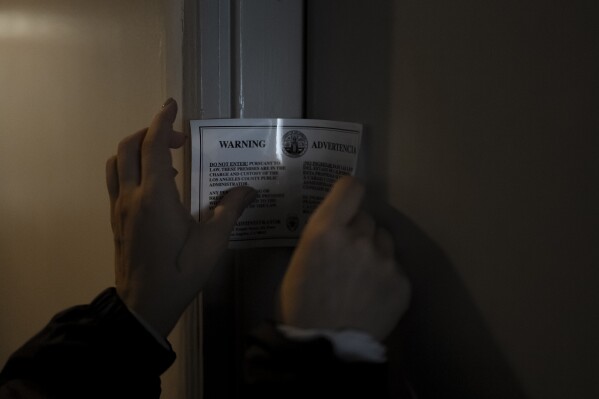
Arusyak Martirosyan, an investigator with the Los Angeles County Public Administrator’s office, posts a seal on the door of a one-bedroom apartment in Los Angeles, Thursday, Nov. 16, 2023. (AP Photo/Jae C. Hong)
The deceased may not have any surviving next-of-kin, or their loved ones can’t afford to pay for an individual burial. Other times, estranged relatives refuse to be involved or a friend is unable to petition a court to take possession of their remains.
Martirosyan, who has been on the job just over a year, said her work has made her keenly aware of her own mortality and spurred tearful but important conversations with her teenage son.
“This is going to happen, in one way or another, to all of us,” she said.
That’s also what largely drives her and the rest of the army of public servants on their quest to bring dignity to tens of thousands of people who die alone in the most populous U.S. county. Their efforts culminate with a communal burial and a multilingual, interfaith ceremony, an event that has been held annually since 1896.
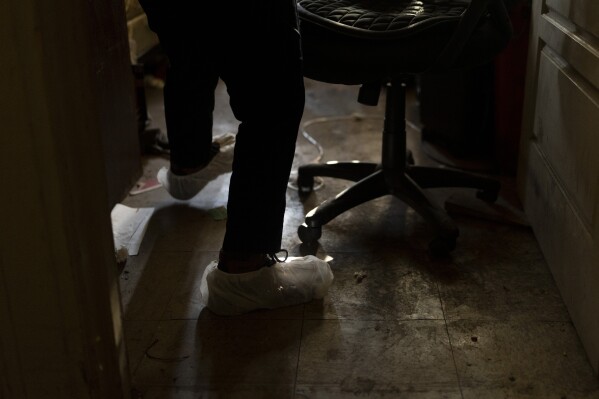
Arusyak Martirosyan, an investigator with the Los Angeles County Public Administrator’s office, enters a micro-apartment to conduct a search in Los Angeles, Wednesday, Dec. 13, 2023, after a tenant was found dead in his bed. (AP Photo/Jae C. Hong)
The most recent ceremony on Dec. 14 recalled the universal devastation and loneliness of the pandemic. The burial of 1,937 people included for the first time those who died from the coronavirus. Among the dead were immigrants, children and homeless people.
“We don’t know enough about the people we are burying today to really do them justice,” county supervisor Janice Hahn said.
Several dozen people, some wiping away tears, attended the outdoor ceremony as clergy members prayed over the communal grave in the county cemetery. Each laid a white rose at the gravesite.
“I wished we could have been there for all of them when they were still alive, in a better way, so that they didn’t have to die completely disconnected and alone,” said Susan Rorke, a local resident who has attended the services for a decade. “I may end up in this graveyard in a ceremony when I die. So I don’t miss this event.”
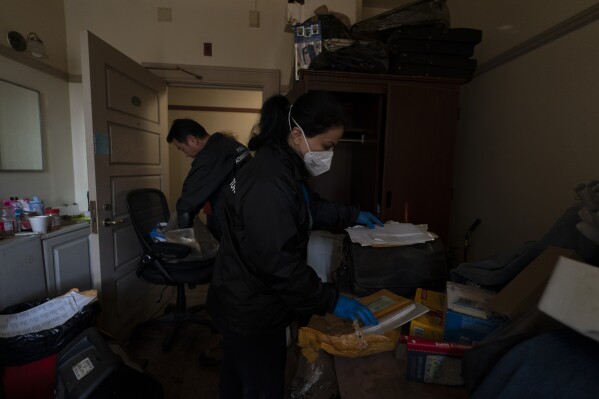
Arusyak Martirosyan, center, and Dennis Cotek, investigators with the Los Angeles County Public Administrator’s office, search through a cramped micro-apartment in Los Angeles, Wednesday, Dec. 13, 2023, after a tenant was found dead in his bed with no apparent next of kin. (AP Photo/Jae C. Hong)
Many people at the service were county employees like Martirosyan and Carlos Herrera, a maintenance worker who has volunteered to help dig the graves for more than 30 years.
In early December, Herrera and his team dug a 14-foot-deep (4.27 meters) plot for the 1,937 plastic boxes containing the ashes of each person and, if known, a label with their names. The site was marked by a flat gravestone. It bears no names; only the year of their deaths, which was 2020 for this group.
Cotek and Martirosyan are just beginning to retrace the life of the 74-year-old woman. The investigators searched her apartment in November, having only a few basic facts in the manila folder, including a local pastor’s phone number and the date when she moved into the apartment: 1988.
Martirosyan methodically flipped through folders in a filing cabinet as Cotek pulled worn black-and-white composition notebooks off a bookshelf.
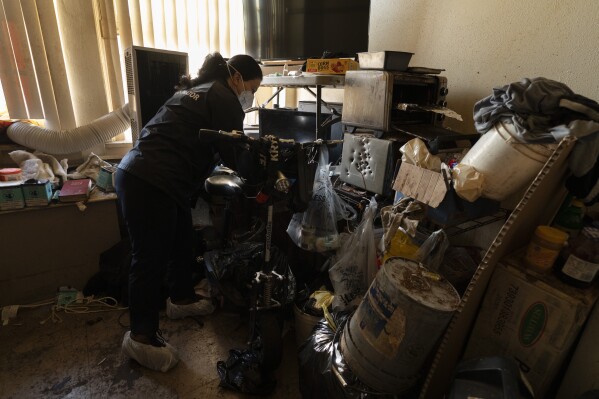
Arusyak Martirosyan, an investigator with the Los Angeles County Public Administrator’s office, searches through a cluttered micro-apartment in Los Angeles, Wednesday, Dec. 13, 2023, for clues that might lead to finding family members or relatives of a tenant who was found dead in his bed. (AP Photo/Jae C. Hong)
Framed Korean Bible verses hung on the walls. They found disability benefit forms, a blank U.S. citizenship application, bank statements — all potentially important clues that went into an evidence bag.
Back at their office in downtown Los Angeles, the investigators handed over the evidence bag to a colleague with a suggestion to look in Korea for potential relatives.
If no one is found after three years, the county will handle the woman’s interment. If she left behind enough money in her estate, her ashes would go into an individual niche with a nameplate in a columbarium, where urns are stored.
While her possessions were not deemed to be worth selling, the county has a warehouse full of boxes of belongings, including vinyl records, Barbie doll collections, classic cars and framed artwork, that it auctions off to pay for niches for other decedents. If there’s not enough to cover that, the person’s ashes will be placed in the communal grave.
The woman could be buried there in 2026.

Arusyak Martirosyan, an investigator with the Los Angeles County Public Administrator’s office, gathers up coins into a plastic bag during her search through a cluttered micro-apartment in Los Angeles, Wednesday, Dec. 13, 2023, where a tenant was found dead in his bed with no apparent next of kin. (AP Photo/Jae C. Hong)
The day after searching her apartment, Martirosyan nets a breakthrough on another case. A woman cries upon learning by phone that her mother, from whom she had been estranged, has died. It’s devastating news for the daughter, but it means her mother won’t end up in the county’s unclaimed grave.
“This is a good day for us,” Martirosyan said. “At least for this portion of their lives, they’re connected.”
But in a county of nearly 10 million, there’s always another life yet to be claimed.
Martirosyan turns to her backlog of cases and begins again.
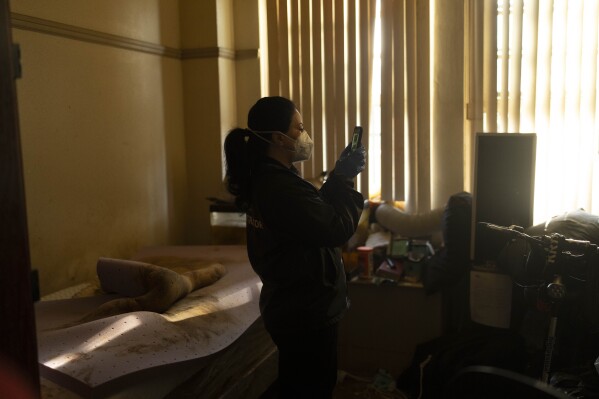
Standing next to a stained bed, Arusyak Martirosyan, an investigator with the Los Angeles County Public Administrator’s office, records a scene with her smartphone while searching through a cluttered micro-apartment in Los Angeles, Wednesday, Dec. 13, 2023. (AP Photo/Jae C. Hong)
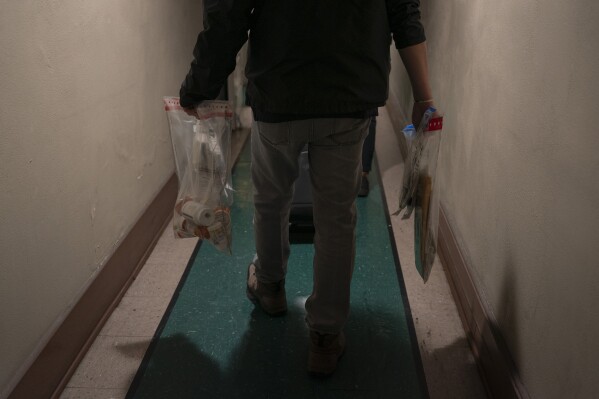
Dennis Cotek, an investigator with the Los Angeles County Public Administrator’s office, carries plastic bags containing documents and personal belongings of a tenant in Los Angeles, Wednesday, Dec. 13, 2023. (AP Photo/Jae C. Hong)
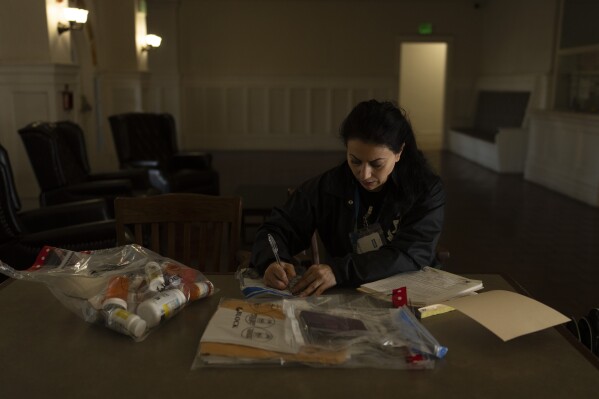
Arusyak Martirosyan, an investigator with the Los Angeles County Public Administrator’s office, makes a list of items gathered during a search through a micro-apartment where a tenant was found dead in his bed in Los Angeles, Wednesday, Dec. 13, 2023. (AP Photo/Jae C. Hong)
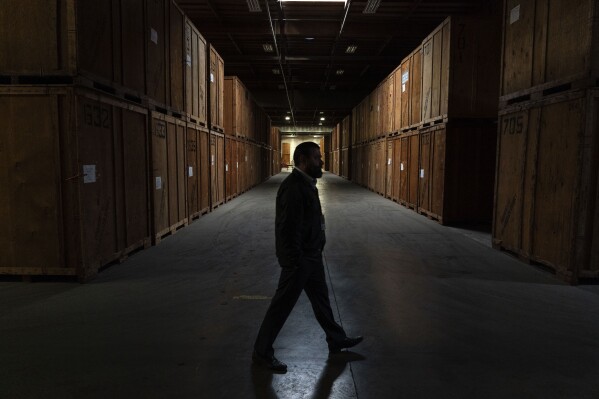
Henry Agadjanyan, operations chief for the Los Angeles County Public Administrator, a branch of the county’s Department of the Treasurer and Tax Collector, walks past the rows of double-stacked wooden crates at a county warehouse in the County of Los Angeles, Calif., Thursday, June 15, 2023. The crates are filled with belongings from people’s estates. The items will be auctioned off to the public to pay off the estates’ debts and burial or cremation services. (AP Photo/Jae C. Hong)
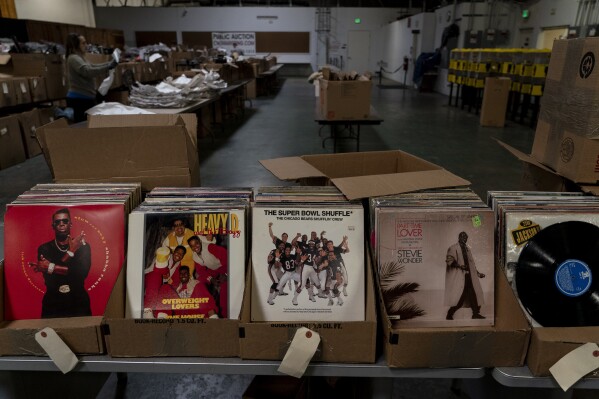
Vinyl records are on display to be auctioned off at a Los Angeles County warehouse in the County of Los Angeles, Calif., Thursday, June 15, 2023. The warehouse is filled with belongings from people’s estates, including anything from doll collections and clothes to framed paintings, china dishware, washing machines, and cars, much of it housed in massive wooden crates. The items will be auctioned off to the public to pay off the estates’ debts and cover burial or cremation services. (AP Photo/Jae C. Hong)
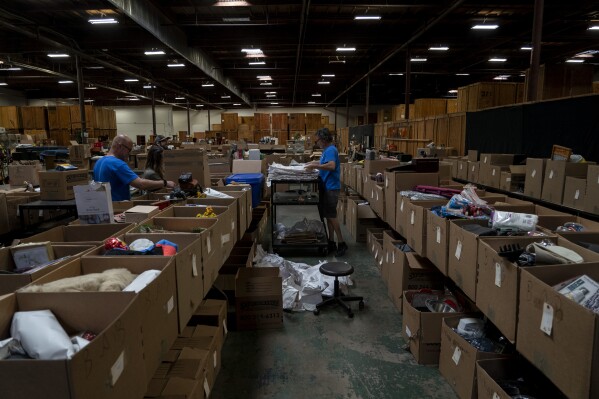
Auction workers sort items at a Los Angeles County warehouse in the County of Los Angeles, Calif., Thursday, June 15, 2023. (AP Photo/Jae C. Hong)
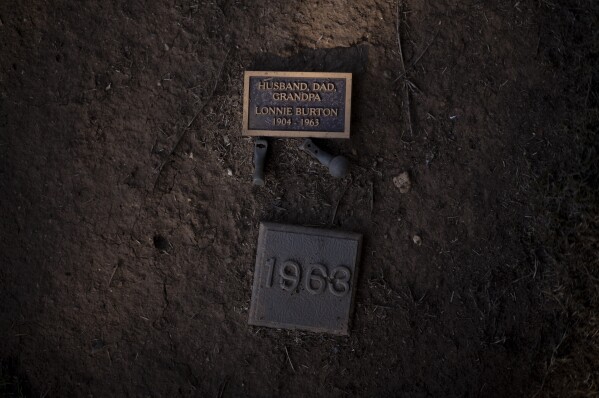
A personalized gravestone, alongside a marker indicating the year that the people died, is seen at a grave for unclaimed county residents at the Los Angeles County Cemetery in the Boyle Heights neighborhood of Los Angeles, Tuesday, Dec. 12, 2023. (AP Photo/Jae C. Hong)
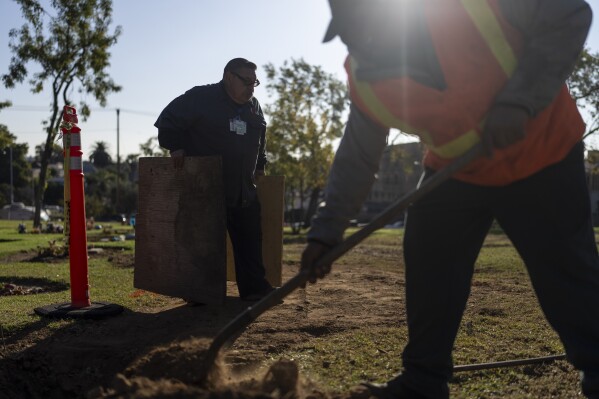
Carlos Herrera, left, a maintenance worker at the Los Angeles County Cemetery, prepares for a communal burial ceremony for the county residents who died unclaimed in the Boyle Heights neighborhood of Los Angeles, Tuesday, Dec. 12, 2023. This year’s service on Dec. 14 laid to rest 1,937 people who died unclaimed in 2020. They were immigrants, children, people experiencing homelessness or poverty, and, for the first time, victims of the coronavirus. (AP Photo/Jae C. Hong)
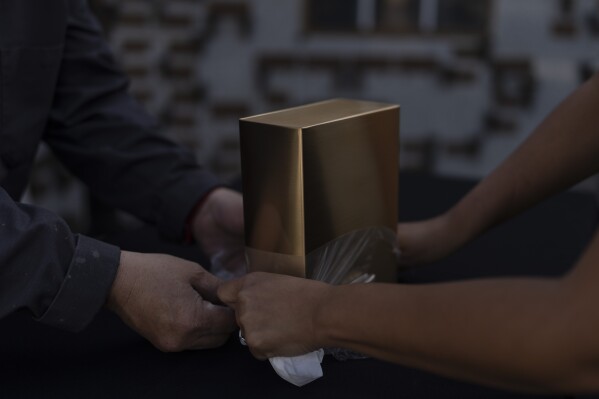
Cemetery worker Jorge Alberto Cortez, on the left, and manager Yuri Hernandez remove the plastic wrap from an urn holding the ashes of an unclaimed Los Angeles County resident as they prepare to place it into a columbarium at Odd Fellows Cemetery in Los Angeles on Thursday, Dec. 14, 2023. (AP Photo/Jae C. Hong)
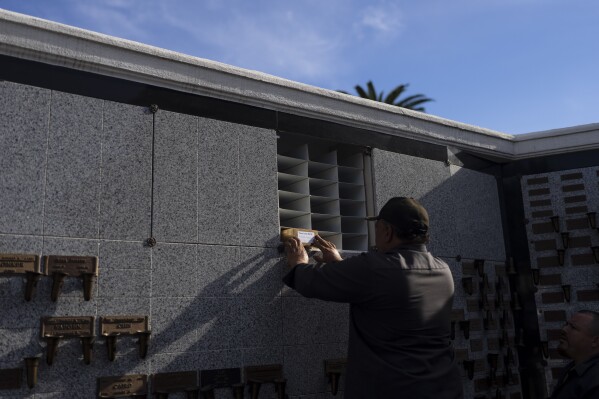
Cemetery worker Jorge Alberto Cortez places an urn holding the ashes of an unclaimed Los Angeles County resident into a columbarium at Odd Fellows Cemetery in Los Angeles on Thursday, Dec. 14, 2023. (AP Photo/Jae C. Hong)
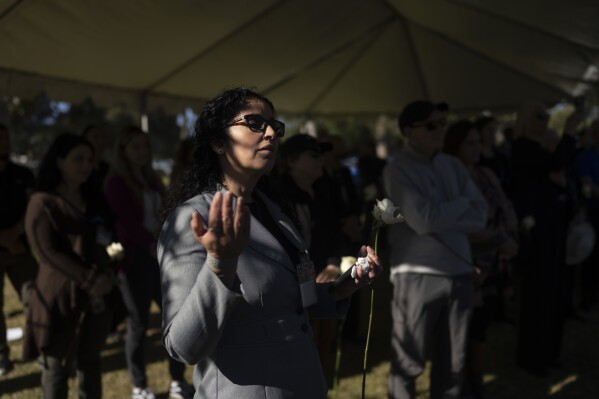
Los Angeles County employee Rosa Gonzalez prays along with other community members during the Los Angeles County ceremony of the unclaimed dead at a county cemetery in Los Angeles, Thursday, Dec. 14, 2023. (AP Photo/Jae C. Hong)
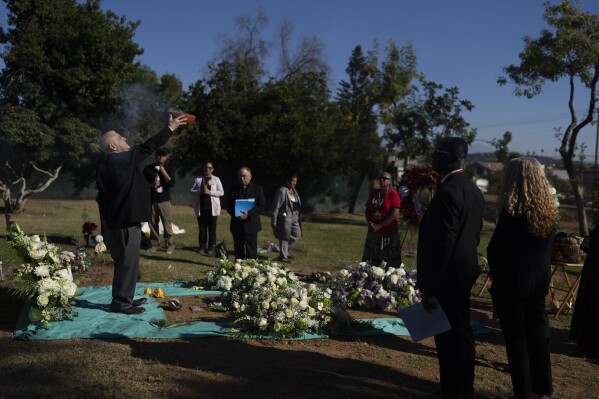
Chaplain Nicholas Jordan, left, holds up a bowl of incense during the Los Angeles County ceremony of the unclaimed dead at a county cemetery in Los Angeles, Thursday, Dec. 14, 2023. (AP Photo/Jae C. Hong)
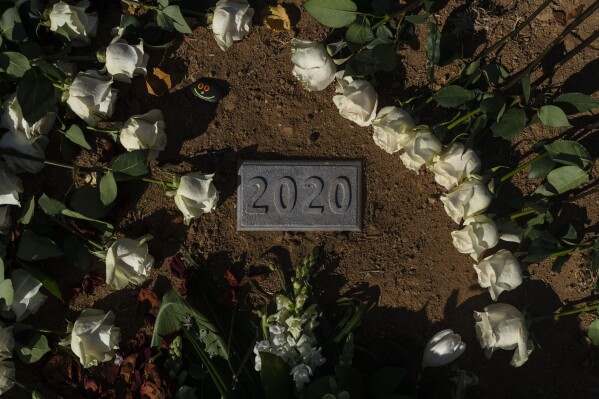
A communal grave for the unclaimed county residents who died in 2020 is adorned with roses during the Los Angeles County ceremony for them at a county cemetery in Los Angeles, Thursday, Dec. 14, 2023. (AP Photo/Jae C. Hong)
Disclaimer: The copyright of this article belongs to the original author. Reposting this article is solely for the purpose of information dissemination and does not constitute any investment advice. If there is any infringement, please contact us immediately. We will make corrections or deletions as necessary. Thank you.






